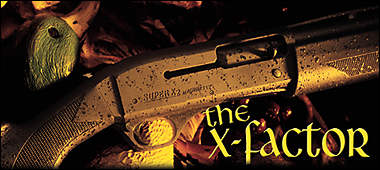
Winchester's new Super X2 12-gauge auto-loader series
recalls the times of the old Super-X line.
By W. T. Woodard
Repeating shotguns outsell fixed-breech over/unders, single-shots and side-by-sides by at least a 10-to-1 margin nationwide, which means hunters must enjoy the advantages conferred by a quick third shot and trim overall gun sizes. I myself have missed many going-away third shots on doves, ducks and geese, so I've often wondered why I don't just plug my gun to two rounds instead of three, as Federal migratory-bird laws dictate, and save a few rounds.
But capacity isn't the only reason to shoot an autoloader: Self-loading guns offer a variety of chamber sizes, stock shape, material and finish selection, with buffered recoil and shootability other factors that come into play. And if the number of offerings wasn't already big enough, the semi-auto field recently became even broader, with the introduction of U.S. Repeating Arms Co.'s Winchester Super X2 line.
Priced from $725 to $938, the X2s come in a variety of finishes, ranging from the 3-inch–chamber field models with walnut stocks to the 3-1/2-inch black synthetic and Mossy Oak Shadow Grass camo guns for waterfowlers. Texas Fish & Game® staffers recently shot two X2s; one was a walnut-stocked 3-inch 12-gauge field gun (listing at $725), which came with 28-inch barrels, and the other a 3-1/2-inch waterfowl gun, which came with 28-inch barrels and a synthetic stock and lists at $855.
The story behind the X2s is either a long one or a short one, depending on how you look at it. Twenty years ago, Winchester sold a Super X shotgun chambered for 2-3/4-inch shells, but discontinued it for a variety of cost and sales reasons. The old Super-X was a solid piece of shotgunning design, with a steel receiver and durable operation. Even so, the gun handled well and pointed quickly, and many Texas hunters have enjoyed eating a brace of doves collected with a Winchester Super-X.
The questions for today's shotgunner are whether the new Super X2s do justice to the reputation of their forebear Super X, and if they are competitive with other similarly priced semi-autos made by Browning, Beretta and Remington. As recent field and range testing showed us, we believe they are.
Shotguns: Handling Is Everything
A shotgun's feel, determined by its stock dimensions and weight distribution, largely determines the wingshooter's success. To see how the X2s fared in this critical area, we compared how the new Winchester guns stacked up against current and past offerings many Texas hunters are familiar with: the Winchester Super-X, the new X2's predecessor; the humpback Browning Auto-5, Browning's 3-1/2-inch Gold Hunter, $735, Browning's 3-1/2-inch Gold Stalker, $735, Beretta's 3-inch AL390 Silver Mallard, $860, and Remington's 3-inch 11/87, $692.
We evaluated them for overall handling, mounting ease, swinging, quick-pointing, and balance. Though different shooters had different reactions to individual guns, we thought the new X2s were able competitors to the current-issue guns from Browning, Beretta, and Remington, and they showed interesting technological edges over the old guns.
In the hands of our shooters, the new Winchesters felt like they had more weight in their barrels and buttstocks, which helped us track flying targets more steadily. This forward weight distribution helped us keep the barrels moving through targets better, which translates into wingshooting success.
On the butt end, though the X2s weighed about the same as the Belgian-made Browning Auto-5, we thought the Auto-5 and Super-X produced much more felt recoil. Reason: The new Winchester guns, along with their stablemate Browning products (both brands are owned by the same company), use a more intricate gas piston than the old guns. The old guns kicked more, we thought, in spite of their similar weights.
Other Shooting Points
As you might expect from guns produced under the same corporate banner, the Browning Gold Hunter and Gold Stalker and Winchester Super X2s are basically the same internally. Though we don't recommend you doing it, we swapped some parts between the two guns and found their firing and function to be unchanged.
The new Winchester Super X2's 3-1/2-inch gun had a black synthetic stock that, like the Stalker's synthetic stock, was slippery, unless the shooter wore gloves - which hunters usually would do in inclement weather. We found that rough leather gripped well on the black plastic stocks.
For the cosmetics-conscious shooter, the Browning and Winchester black guns aren't too pretty. Nearly every part of them was flat black, which would be the right look on a working waterfowling gun. Even the cartridge carrier on the bottom is flat black, and like that of the new Browning it swung easily out of the way to load the magazine. The trigger and bolt were the same flat black as the ventilated rubber recoil pad, and all that lack of reflective surfaces gave the Winchester a very business-like appearance.
The 3-1/2-inch X2s, offered in 24-, 26, and 28-inch varieties, are only available in black-matte synthetic finishes, like Browning's 3-1/2-inch Stalker. On the 3-inch gun, the Winchester Field wood-stocked model had nicely finished wood and deep bluing on its receiver and barrel, and we thought it was cosmetically comparable to the Beretta 3-inch Silver Mallard.
The Super X2s' 28-inch barrels had 3/8-inch-wide ventilated ribs attached to them, and like the Brownings, they used Invector choke tubes. The front of the ribs had 1/8-inch-diameter pearl-finished beads. The new guns fed, fired and ejected short and long cartridges perfectly. Any difference in felt recoil between the Brownings and the new Winchesters is entirely due to their weight differences, because the guns use identical gas systems.
continued
page 1 / page 2
|

